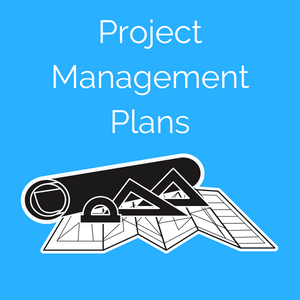Do you know the 5Ps? Proper Planning Prevents Poor Performance. Why is it that some project managers put so little time in developing a project management plan?
Some project managers may not know what to include. I've developed this checklist to help you develop your project management plan including baselines, subsidiary plans, and ancillary plans.

Tailor the Project Management Plan
Every project is different. Select only the planning elements that are appropriate for the size and complexity of your projects. The project plan may be general or detailed depending on the needs of the project team.
Focus on keeping the plans simple and practical. Engage your team members in developing the plans. This will greatly improve the quality of the plans and the buy-in. Otherwise, people will ignore the plans.
First, let's look at three baselines that you may wish to include: the scope, schedule, and cost baselines.
Harry Hall, the Project Risk Coach
More...
What is a project management plan?
The project management plan is “the document that describes how the project will be executed, monitored and controlled, and closed." (PMBOK® Guide—Seventh Edition).
Project Management Plan Baselines
So, what exactly is a baseline? A project baseline is a snapshot against which all future measurements will be compared. For example, a project manager can compare actual completion dates of activities to an approved schedule baseline.
Think about this. Without a baseline, how will you monitor and control your projects?
- Scope Baseline
- Project Scope Statement - describe the products, project work, major deliverables, assumptions, and constraints
- Work Breakdown Structure - create a hierarchical decomposition or outline of the scope of work to achieve the project objectives and to create the deliverables
- Work Breakdown Structure Dictionary - provide the detailed information about the deliverables, activities, cost estimates, and scheduling information for each item in the WBS
- Schedule Baseline - approved version of the schedule
- Cost Baseline - approved version of the project budget
Project Management Plan: Subsidiary Plans
The overall project management plan includes subsidiary components such as the scope management plan, quality management plan, and resource management plan.
Develop the subsidiary plans that will provide value to each project. It is highly unlikely that you will need all ten of the plans listed below for one project. Keep it simple, particularly for smaller projects.

Ancillary Project Plans
Lastly, consider ancillary plans for your project management plans. For example, when I manage software development or configuration projects, I always include the requirements management, change management, and configuration management plans.
- Requirements Management Plan - describe how you will identify, analyze, document, and validate requirements.
- Change Management Plan - describe the process for managing changes in the project.
- Process Improvement Plan - describe how you will evaluate and improve the project processes to enhance the value, decrease cost, and expedite delivery.
- Configuration Management Plan - describe how you will identify and document the functional and physical characteristics of a product, service, or result.
Project Management Plan Checklist
Not sure of what to include in your project management plans? The Project Management Plan Checklist will help you pick the right project baselines, subsidiary plans, and ancillary plans for your projects.
Additional Tips
- Work with the project team to think ahead. Discuss the development and testing of the product, service, or result. Identify threats and opportunities. Define your project plan accordingly.
- Focus on collaboration, communication, and stakeholder buy-in.
- Keep the project plan as simple as possible.
- Determine your project life cycle. Will the project be a plan-driven project or a change-driven project?
